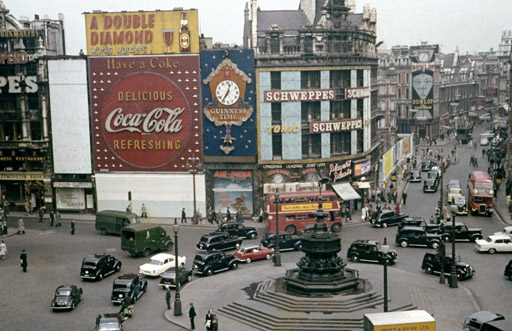Characterisation, illusion and identity in The Lonely Londoners
I have already referred to the disjunction between what Caribbean migrants expected to find in England and their actual experiences. For David Dabydeen and Nana Wilson-Tagoe:
The Lonely Londoners deals with the shattering of the illusion of belonging, the illusion of being English, and indeed the illusion about who the English are. The journey to England is a journey to an illusion, and the sojourn in England is a shattering of that illusion. The illusion is, firstly, a material dream about the wealth of England – the streets are meant to be paved with gold, with work well-paid and readily available. Secondly, it is an illusion about the courtesy, hospitality and human warmth of the English. The illusory hospitality of the English involves an imagined willingness of their white women to readily accept black men. …
Finally, the illusion of England involves a romantic sense of English history. Names like Charing Cross, Waterloo and Trafalgar Square are powerfully seductive. … The seduction of England is the illusion of its romantic or fabulous history, and the illusion that the West Indian could participate in that history. It was a powerful dream especially since West Indians were taught, through colonial education, that there was no history or romance or fable in the islands; that all history resided in England.
In the novel, all the dreams are painfully destroyed by the reality of their encounter with the actual England.
These illusions are explored in the novel, linking together the otherwise seemingly fragmented ‘ballads’, or anecdotes that relate the characters’ exploits. However, the novel’s treatment of these shattered illusions is not simply a case of recording examples of an idealised vision of England coming up hard against the reality of post-war life in London. Selvon presents this theme in a variety of ways.
Activity 3
First, reread the ‘Bart’ section (from ‘During them first days’ on p. 45 to ‘in the world, too’ on p. 52) of the novel.
- How does Selvon present Bart and develop the reader’s sense of his character? How would you describe the different moods and literary techniques used in this section?
- To what extent is Bart shown to be a victim of the illusions described above by Dabydeen and Wilson-Tagoe?
Discussion
- Bart is presented initially in comic terms, focusing on his almost pathological meanness with money, which leads him to deny himself food in order to avoid helping a friend in difficulties. Humour is the prevalent element in the first part of this section, with a characteristic anecdote involving Bart and Cap showing the quick, sly wit that Bart shares with a number of other characters – ‘Come back by the two and six ear’ (p. 47) – rendering him a more sympathetic character than he first appears.
Bart also appears to be a reluctant member of the West Indian community, trying to pass himself off as ‘Latin-American’ (p. 46) because of his lighter skin, and avoiding the company of blacker members of the community: ‘he always have an embarrass air when he with them in public, he does look around as much as to say: “I here with these boys, but I not one of them, look at the colour of my skin”’ (p. 48).
The relatively humorous tone gives way to a darker mood as Bart encounters racial prejudice, ironically described as ‘the old diplomacy’ (p. 48). His increased exposure to discrimination is accompanied by a physical decline; the comic refusal to eat in case by doing so he will have to share his resources with a fellow sufferer gives way to a more psychologically troubling act of denial as he ‘train himself to live only on tea for weeks’ (p. 48).
There is another shift of mood once Bart recovers from his illness, and the focus of the narrative moves to his obsession with his white girlfriend, Beatrice. Pathos becomes the prevailing mood of the remainder of the extract as Bart loses the object of his affection. His fruitless search for her is rendered movingly, with heightened emotion and diction, while maintaining the Caribbean idiomatic narrative voice:
- He must be comb the whole of London, looking in the millions of white faces walking down Oxford Street, peering into buses, taking tube ride on the Inner Circle just in the hope that he might see she. For weeks the old Bart hunt, until he become haggard and haunted.
- (pp. 51–2)
The simple and reflective tone of the narrator’s rueful observation – ‘It have men like that in the world, too’ (p. 52) – concludes this section with what Ramchand calls ‘acceptance and a quiet awe’ (1985, p. 11).
- Clearly, Bart falls prey to the shattering of at least the first two of the illusions outlined by Dabydeen and Tagoe-Wilson. The falsity of the belief in plentiful work is implied firstly in Bart’s reluctance to help his associates financially. On achieving the coveted security of regular work, Bart even seems to internalise English prejudices and reflect it back in his attitudes: ‘Many nights he think about how so many West Indians coming, and it give him more fear than it give the Englishman, for Bart frighten if they make things hard in Brit’n’ (pp. 47–8).
He also encounters the lack of ‘courtesy, hospitality and human warmth’, having doors slammed in his face and being ejected from Beatrice’s house by her father. Furthermore, the ‘imagined willingness of their white women to readily accept black men’ is also brought into question by Beatrice’s disappearance. Bart’s ceaseless quest for Beatrice is in one sense heartbreakingly futile, but could also embody the resilience that many of these characters demonstrate as a response to the prejudice they face on a daily basis.
The character of Beatrice, perhaps, represents an example of the significance of naming in the novel in relation to the canonical literary tradition with which it engages, often subversively. Beatrice shares her name with Dante’s (1265–1321) guide through Paradise in the last book of his epic poem Divine Comedy (1307–21). The impact on Bart of his Beatrice’s disappearance could be seen as a subversion of the role of Dante’s Beatrice, in that Bart descends into a personal hell as a consequence of losing her. It is possible here to see Selvon’s novel in a complex intertextual negotiation with more canonical forms of literature.
Skin colour is central to these characters’ alienation. Bart’s denial of the implications of his colour is symptomatic of a destabilising of identity resulting from the experience of racial prejudice, a disassociation by Bart from his own sense of self; his outward alienation is mirrored by an inner one. Bart is forced to recognise that this alienation is what connects him to the other West Indian migrants, forcing him eventually to ‘boil down and come like one of the boys’ (p. 48).
A disassociation from skin colour is also apparent in Galahad’s attempts to come to terms with white attitudes to Caribbean immigrants, as he addresses his colour as though it were something separate from himself:
And Galahad watch the colour of his hand, and talk to it, saying, ‘Colour, is you that causing all this, you know. Why the hell you can’t be blue, or red or green, if you can’t be white? You know is you that cause a lot of misery in the world. Is not me, you know, is you! I ain’t do anything to infuriate the people and them, is you! Look at you, you so black and innocent, and this time so you causing misery all over the world!’
This is a rare reflective moment for Galahad, a character with a surer sense of self than most in the novel. That even he is affected in such a way as to try to divorce himself from his colour is indicative of the insidious power of racism. Galahad’s more usual way of defining himself is very different from Bart’s, however, as is his attitude towards women, which is significant in relation to the novel’s wider engagement with issues of gender, the subject of the next section of this course.

